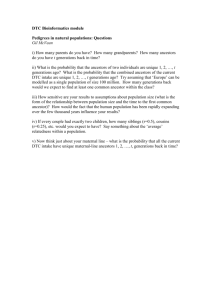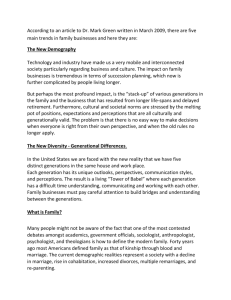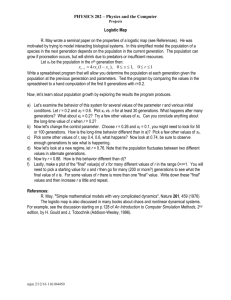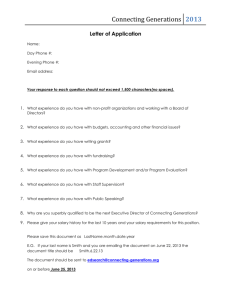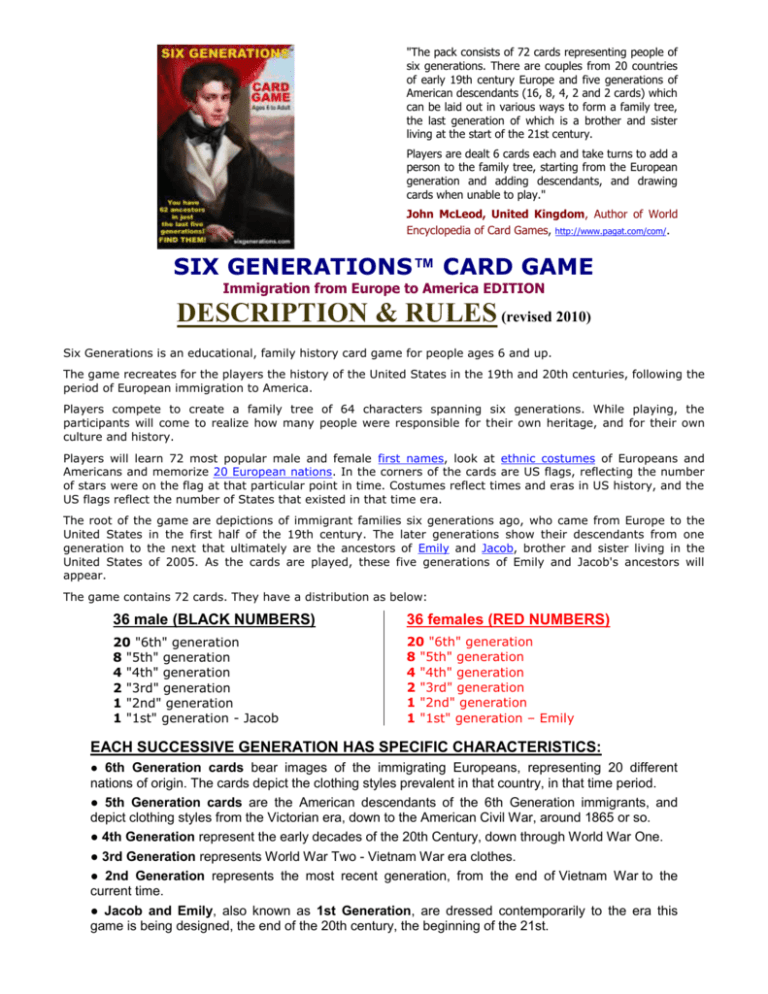
"The pack consists of 72 cards representing people of
six generations. There are couples from 20 countries
of early 19th century Europe and five generations of
American descendants (16, 8, 4, 2 and 2 cards) which
can be laid out in various ways to form a family tree,
the last generation of which is a brother and sister
living at the start of the 21st century.
Players are dealt 6 cards each and take turns to add a
person to the family tree, starting from the European
generation and adding descendants, and drawing
cards when unable to play."
John McLeod, United Kingdom, Author of World
Encyclopedia of Card Games, http://www.pagat.com/com/.
SIX GENERATIONS™ CARD GAME
Immigration from Europe to America EDITION
DESCRIPTION & RULES (revised 2010)
Six Generations is an educational, family history card game for people ages 6 and up.
The game recreates for the players the history of the United States in the 19th and 20th centuries, following the
period of European immigration to America.
Players compete to create a family tree of 64 characters spanning six generations. While playing, the
participants will come to realize how many people were responsible for their own heritage, and for their own
culture and history.
Players will learn 72 most popular male and female first names, look at ethnic costumes of Europeans and
Americans and memorize 20 European nations. In the corners of the cards are US flags, reflecting the number
of stars were on the flag at that particular point in time. Costumes reflect times and eras in US history, and the
US flags reflect the number of States that existed in that time era.
The root of the game are depictions of immigrant families six generations ago, who came from Europe to the
United States in the first half of the 19th century. The later generations show their descendants from one
generation to the next that ultimately are the ancestors of Emily and Jacob, brother and sister living in the
United States of 2005. As the cards are played, these five generations of Emily and Jacob's ancestors will
appear.
The game contains 72 cards. They have a distribution as below:
36 male (BLACK NUMBERS)
36 females (RED NUMBERS)
20 "6th" generation
8 "5th" generation
4 "4th" generation
2 "3rd" generation
1 "2nd" generation
1 "1st" generation - Jacob
20 "6th" generation
8 "5th" generation
4 "4th" generation
2 "3rd" generation
1 "2nd" generation
1 "1st" generation – Emily
EACH SUCCESSIVE GENERATION HAS SPECIFIC CHARACTERISTICS:
● 6th Generation cards bear images of the immigrating Europeans, representing 20 different
nations of origin. The cards depict the clothing styles prevalent in that country, in that time period.
● 5th Generation cards are the American descendants of the 6th Generation immigrants, and
depict clothing styles from the Victorian era, down to the American Civil War, around 1865 or so.
● 4th Generation represent the early decades of the 20th Century, down through World War One.
● 3rd Generation represents World War Two - Vietnam War era clothes.
● 2nd Generation represents the most recent generation, from the end of Vietnam War to the
current time.
● Jacob and Emily, also known as 1st Generation, are dressed contemporarily to the era this
game is being designed, the end of the 20th century, the beginning of the 21st.
GAME DURATION:
A game can last from five to thirty minutes, depending on strategic play, cards drawn,
and the speed at which the players recognize Couples.
HOW TO WIN THE GAME:
The first person to run out of cards wins the game.
ALTERNATE RULES:
The game may also be played until only one player is left.
HOW TO PLAY:
● Shuffle the deck and deal six cards, one at a time face down to each player.
Players may pick up and hold these cards as a ‘hand’. Place the rest of the deck face
down in the center of the table, reachable to all players.
● Each player must play a card, if able, onto the table top. If he cannot play, a
player must draw a card from the top of the Deck, until one he draws CAN be played.
CARDS MUST BE PLACED WITH THE FOLLOWING RULES:
1. In the beginning of the game, a player MUST play a 6th Generation card.
2. A 6th Generation card that “Makes a COUPLE” is one that is of the same
rank, of the opposite sex, that is from the same Nation.
3. A 5th Generation card cannot be played until a 6th Generation COUPLE is on
the table. A 5th Generation card played on a COUPLE of 6th Generation is their CHILD.
Whenever a CHILD is played on a previous generation, the older generation cards are
removed from play (they are “completed”.) Place completed couples face down adjacent
to the deck (they are not used for the rest of the game.)
4. A 4th Generation card cannot be played until two 5th Generation Parents of
opposite sex are in play, and so on down to Emily and Jacob. The players may build on
these sets as their turn comes, either placing one card or drawing from the deck if
necessary until one may be placed.
NOTES:
► If a player doesn't have the correct card to play, he must draw from the deck until he
does;
► Any player must place no more than one card during his or her turn;
► Sixth Generation is the only Generation which may be placed on the table without
being a Child to an earlier Generation;
► Only one Child can be played on a Couple. (Firstborn children are the only ones this
game tracks.)
► It is possible for a player to run out of cards (and win the game) before Emily and
Jacob are played.
► Each set is built up with a male and female from each generation, #6 down to #1.
► There are total of six rows the players can build in this game; each row, or line,
represents new generation.
WILDCARD PLAY:
If at any time of the game one player gets both cards #1 (Emily and Jacob) they can be
played down below the Generations, regardless of whether their parents are yet in play.
This is the only time you can play more than one card out of your hand at one time.
KEY STRATEGY:
Since each player may only play one card per turn, when you play a 6th Generation
card, do NOT identify the COUPLE it makes until you need to use it by yourself at one
of your next turns. Watching the 6th Generation cards even while you are looking for
places to play your later Generations, you can sometimes catch a Couple others are
missing, and maybe get rid of one of the spare 5 Generation cards in your hand.
FULL SET of 72 CARDS
(sample family)
One family from Europe could not get the
right paperwork and permission to leave their
country.
One family from Europe died because their
boat sunk in the Atlantic Ocean.
One family from Europe came to America,
but did not have children.
One family from Europe changed their
plans to go to America because they decided
to stay happily in their homeland.
There are eight cards with four families
from Europe who did not have children in
the United States of America because of
four different reasons.
SIX GENERATIONS GAME REVIEWS
OFFICIAL WEBSITE: HTTP://WWW.SIXGENERATIONS.COM
BookWire Review, May 18, 2005
"Six Generations: Immigration From Europe To America Edition", an innovative
card game designed and published by Fyodor Soloview, is a pleasant example of
information coupled with entertainment. This game contains a set of 72 cards with
pictures of six generations of immigrants belonging to a family who came to the
United States from sixteen European nations in the first half of the nineteenth
century. The latest generation consists of the siblings Emily and Jacob, currently
living in the United States; and the other five generations represent their
ancestors.
The 72 cards, comprising pictures of 36 men and 36 women, are divided into six
categories. Each category portrays a different generation. Players are dealt six
cards each, and they are allowed to dispose of a card when the person whose
picture is printed on it matches the generation of the card played by the previous
players. The ultimate objective of the game is for each player to get rid of all her
cards, and the winner is the first one to do so.
Recommended for ages six to adult, "Six Generations" is a highly engaging
concept aimed at providing wholesome entertainment. It would be a welcome
addition to any family's personal collection of games. This game also has
educational value, as it provides useful clues to the different types of clothing worn
by the people from different nations and time periods that are featured on its
cards. Fyodor Soloview's creative idea is well complemented by the appealing
artwork of Andrey Ayoshin and Lyudmila Lygina.
This review available as PDF files at:
http://www.bookwire.com/bookwire/PDF/soloview.pdf
WHAT IS SIX GENERATIONS?
Fyodor Soloview, author of Six Generations Playing Cards. 2005.
Six Generations is a modern deck of
playing cards and historical images,
created with a help of a science,
called genealogy.
Genealogy,
combining the knowledge in history
and genetic about our families and
ancestors, helps us to answer many
questions of the present and the past.
This is one that kind of question. Why
do all regular playing cards have
King, Queen and Jack as the only
costumed characters?
The answer is: the modern playing
cards have been created in Venice,
Europe seven centuries ago during
the monarchy, and no other family
members could join the Royal family
as an equal party. That's why other
cards in the deck became the
boring numbers, from two to ten.
The evolution of society made all
people
equal.
But
we
were
playing the old monarchic cards, and
didn't really have a choice to follow
the history... until now. We are happy
to introduce new, democratic deck of
playing cards for all your gaming
needs. This is real revolution in card
games! And each card has a picture
of a man or a woman in a colorful
costume from the country and time
they are from.
This pack consists of 72 cards
representing
people
of
six
generations. There are couples from
20 countries of early 19th century
Europe and five generations of
American descendants (16, 8, 4, 2
and 2 cards) which can be laid out in
various ways to form a family tree,
the last generation of which is a
brother and sister living at the start of
the 21st century.
With this new deck of cards, the
game players and inventors may
create hundreds new card games.
This deck comes with the rules of the
first genealogical, solitaire-type card
game SIX GENERATIONS, based on
new structural concept of Six
Generations playing cards. The rules
of other card games are available at
this web-site on the page GAMES
and others.
Please, read the rules and learn how
to play, read the reviews about Six
Generations playing cards, and check
where to order them. And enjoy
playing the card games with your
friends, family and children!
RULES OF ALL CARD GAMES ARE AVAILABLE AT THIS WEB PAGE:
http://www.sixgenerations.com/Six_Generations/Games_description.html
New Playing Cards 'Six Generations' Are Invented Unexpectedly
ANCHORAGE, Alaska, Sept. 22, 2005 /PRNewswire/ --
The monarchic structure of standard
playing cards with King, Queen and Jack is
now breaking apart by an Alaskan game
designer who invented a new "democratic"
deck with a 64-person family in six
generations.
When Fyodor Soloview, a graphic
designer from Alaska was searching his
genealogy with the roots of Russian,
German, and Ukrainian ancestors, he
caught an idea that anybody's trianglelooking family tree could be used to create
a new card game.
After a year of research and
choosing a universal match for parents and
children, husbands and wives, lifestyle and
clothing, names and countries for the
European family of immigrants to America,
his idea has generated an innovative card
game, "Six Generations."
"The amount of our ancestors is
doubled in each older generation," Fyodor
Soloview said. "We have two parents, four
grandparents, eight great-grandparents,
and so on. In six generations we get 62
ancestors. It's a perfect amount for cards in
a deck, since we need to shuffle them
easily. That's how I stopped at number
six."
Fyodor Soloview did not think twice
to name an immigrant from Austria -"Arnold." A man from England was
"Charles," from Germany -- "Karl." All first
names were taken from the bureau of vital
statistics to display the most popular from
the times they were from.
Generation #1 in the game consists
of the siblings Emily and Jacob – their
names keep the record popularity for
newborns in the U.S. since 1996."
The surprise came later, when this
solitaire-type card game was already
printed by Carta Mundi, a U.S. game
manufacturer, in September 2004. After
making the first sales, Fyodor has realized
that this genealogical deck was not just a
single game "Six Generations," but a
modern-looking pack of “democratic"
playing cards.
"My customers asked me the quick
explanation of this game. I told them, it's
like playing cards. But instead of three
characters of King, Queen and Jack, in my
deck each card is a costumed member
from a non-monarchic family. Here we
match husband and wife, children and
parents, but not the boring numbers
anymore. It's not a fight between four suits;
it's matchmaking and creation of the
family."
Some other card games, like "21,"
were easily adopted with new playing
cards. But to play poker, Fyodor Soloview
wrote new rules, calling the game
"Genpoker." The website he designed,
http://www.sixgenerations.com, has the
new rules and details.
"Six Generations" is opening the
door for other game inventors to create
dozens new card games, or converting the
old ones. It might take some time before
Las Vegas will accept this new deck to play
poker in their casinos, but the time could
come.
New Genealogical Card Game for Children “Six Generations”
by Alaskan Inventor Fyodor Soloview
Can Spark Population Growth in U.S.A., Canada, Europe and Russia.
ANCHORAGE, Alaska, September 20, 2006 /PRNewswire/ -Alaskan inventor Fyodor Soloview
discovered a simple way to increase fertility
rates of future parents, now 5-12 year-old
children, by pointing their interest to
genealogy and saving their dynasty from
extinction.
The governments of European nations
have been worried about progressive
declines in populations, which will face them
with serious shortage of labor. Nobody had
an answer before as to how to secure an
average fertility rate of over 2.1 babies per
woman, which required human reproduction.
To fix this dilemma, Soloview said,
governments, schools and parents should
educate children in family genealogy. At
home, children must observe the family tree
with several generations of their ancestors.
To help the parents, Fyodor Soloview, a
father of four children, designed the family
history card game Six Generations, which
looks like a deck of playing cards.
last 'survivor' of that dynasty. If they never
produce their own children, their whole family
'kingdom' will be destroyed. Saving their
family from extinction will become their lifetime mission from now on.
Kids, who have an ability to identify
themselves with the heroes of the games, are
going to put themselves in the place of Jacob
and Emily -- siblings who are representing the
youngest generation in the Six Generations
card game. To "jump" one generation up, the
child needs to grow up, get married and have
several babies.
This non-violent game teaches why
everyone has 62 ancestors in just the last five
generations. Colorful drawings of 72 people in
the deck are supplemented with different first
names, which, according to the vital statistics,
are the most popular from the time and 21
countries they are from.
"In the modern world of democracy,
the members of a family tree circle should be
printed on the playing cards, instead of Kings,
Queens and Jacks, which have been
representing the political ideology of
monarchic Europe for seven centuries,"
Soloview said. "Playing cards can teach
children about genealogy and family values."
Soloview, a former bilingual tutor at
elementary schools in Anchorage, was
surprised that students are forced to deal with
playing cards depicting monarchs.
"You just let you children play Six
Generations, and they will figure it out by
themselves, what their own role in securing
their family dynasty is," the inventor said.
"There will be questions, of course, about the
names of their great-grandparents. Even if
you can't answer, your children will discover
with a big surprise that their kin goes back
thousands of years, and that each child is the
"George Washington finished with the
monarchy in America in 1776, and I
completed his mission in 2004, designing
democratic playing cards without royal suits,"
Soloview declared.
The Six Generations card game is sold
at http://www.amazon.com/dp/0976041804/
and at the publisher's web-site,
http://www.sixgenerations.com, for $8.97.
Six Generations: One Deck, Many Games
By Karen Luciana, Games for Educators website. January 25, 2010
Six Generations is a
card game that offers
many appealing lures
for children. Creator,
author, and designer,
Fyodor Soloview put
much research, thought
and
creativity
into
developing the deck of
cards with which there are several different
games to be played.
the study of historical people. Additionally,
one of the games requires players to
observe the lineage of ancestors to current
day people. Playing that particular game is
an excellent visual tool to use to
demonstrate to students how history really
does
influence
present-day
times.
Therefore, Six Generations earns an A for
this category also.
When I review games, please remember I
do so from a teacher’s standpoint and look
at the use of the game in the classroom and
with ties to curriculum and education.
Another benchmark on which I evaluate is
ease of learning and instructions.
Six
Generations earns a C+ here.
The
instructions are not simple to follow. We
had to re-read the directions and experiment
with play several times in order to grasp the
object of the many of the games.
Enthusiasm
My first criterion is the enthusiasm the game
elicits in children. Six Generations earns an
A for that category. I introduced the game at
the beginning of this school year to my fifth
graders. I teach 3 sections and each group
responds with excitement when I announce
that they will be playing the game. Common
reasons they provide is that the games are
fun and they like looking at the colorful
pictures of the characters on the cards.
Ease of Learning
Replayability
Finally, I usually ask myself if the game will
remain in my cabinet or be used over and
over again. B+ for this category. We often
pull the cards out to play, as one of the
games can be played fairly quickly, a real
plus in the school setting.
In Closing
Curriculum Ties
This artwork leads into my next criterion. I
also evaluate games based on the curricular
ties I can make in the classroom. I am
impressed with the amount of educational
research that obviously went into creating
this lovely deck of cards. Each of the six
generations cards has a colorful, authentic
representation of a person who lived within
the timeframe of its generation. The clothing
is quite detailed and accurate. For this
reason, the cards can be used to enhance
A final note is the Six Generations has a
very detailed and user-friendly website
(www.sixgenerations.com) that is easy to
maneuver and from which interested players
will receive valuable information.
Overall, I highly recommend the use of this
game in your classrooms. Students from
grades 5-9 will find the game fun and
entertaining. It will be a nice addition and
enhancement to your curriculum.
This article available at GAMES FOR EDUCATORS website:
http://www.g4ed.com/index.php/game-reviews/322-game-review-six-generations
ABOUT THE PUBLISHER AND THE PRODUCT
Location
Six Generations Publishing
9048 Little Brook Street
Anchorage, AK (Alaska) 99507-4922, U.S.A.
Phone: 1 (907) 563-9999
Fax: 1 (907) 522-9433
E-mail: soloview@gci.net
Today, society has changed. Nobility is no longer
genetic… it is in the individual character. To hold onto
our heritage and history, the family genealogy of
every ancestor is important. Thus, the new version of
the playing cards, Six Generations, was designed.
Six Generations Card Games. 72 cards
MSRP $8.97
ISBN 0-9760418-0-4
Games catalog code: 6GN 1000.
First edition published in September 2004.
Six Generations cards became the ultimate deck for
all nations, reflecting the reality of US history… we
are a nation of immigrants. The current deck, showing
the immigrating Europeans to America, is just the
sample of what could be done later by the numerous
designers around the world. This product could be
licensed around the world, having revenues from
billions of copies sold - from for the home usage to
the casinos.
Creators
Product Mission
Inventor of Six Generations cards, author of
card games rules, graphic design - Fyodor Soloview.
Six Generations Card Game basic rules editor:
Plesah Wilson.
To replace the traditional card decks with one that
meets current geopolitical conditions, rather than
promote the old imperial structure. Once there are a
compelling number of games that can be played
with Six Generations cards, there will be a transition
away from the suited and royalty based card games,
and a move to play more, different games with Six
Generations cards.
Six Generations Card Game full version rules editor:
Jonathan Albin.
Product Vision
Game Information
Art work: 72 images on the cards by Andrey Ayoshin
(about, art gallery); European man on the front cover
by Lyudmila Lygina.
The Heirs Card Game editor: Keven Parret.
Special thanks to Joan Severa and her book
"Dressed for the Photographer: Ordinary Americans &
Fashion, 1840-1900 for photo images.
Copyright Information
SIX GENERATIONS is a registered trademark of Six
Generations card games/playing cards. All rights
reserved. Copyright from 2004 by Fyodor Soloview.
The information about Six Generations card games
may be copied and reproduced in any form for
educational,
promotional,
advertisement
and
entertainment purposes, and for sales of this card
game, and for no other purposes without the
permission from the publisher.
Product Introduction
As an encyclopedia of the world fashion designs, Six
Generations deck can attract many famous artists, as
well as the old illustrations might be used as well.
The standard playing cards have been on the market
for 700 years. By making the cards representative of
generic Kings and Queens, they have survived. Add
to that the literally myriad games that are playable
with them and their utility are obvious.
Six Generations is a Revolutionary and ‘thinking
man’s” card game, challenging the valuation of the
card system of “Standard Decks”. The deck’s
distribution of value is geometric, rather than linear, in
progression. Play develops a chess-like appeal, as
the players begin to develop strategies three and four
turns ahead of their current situation. With broader
reach, and other artists and cultures, Six
Generations can expand into an international
business model, with version available all over. This
product has perfect usage in education, arts,
museums, and homes.
Product Position
A uniquely developed product with museum quality
artwork and genealogically and historically
interesting mechanic, Six Generations is a singular
product challenging the status quo of what the
world has come to call “a deck of cards”.
Current focus is on those with a genealogical bent,
but the intent is to broaden that base to include
game players at large. It is a quality game, but the
real and present value is as a genealogical and
historical gift product. This focus and aim is clear
not only in the level of detail that has gone into
development, but also in the focus and in intent of
its designer in his current promotion and rhetoric.
HOW WE MADE THE CARDS
To create some images, we used a few 19th century photos, like shown below.





